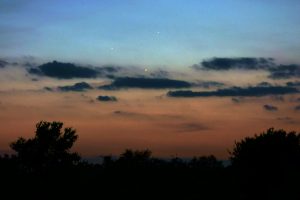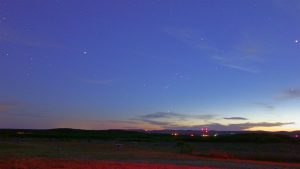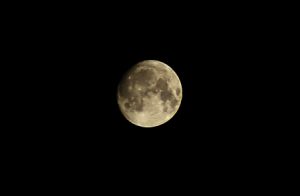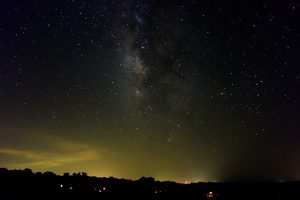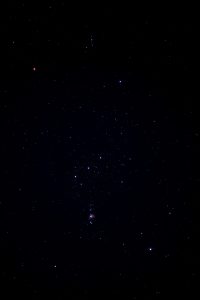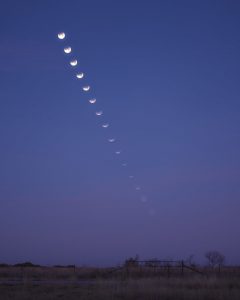Editors Note: In his Coat Pocket Astronomy article Rob Pettengil takes miniature astroimaging to the test with gear that literally fits in his pocket. Images 3 – 9 can be found at the end of the article.
My affection for the miniature drove my interest in ultra-light astrophotography. I like to call it “Coat Pocket Astronomy” and my goal is to push my boundaries and see just how portably I can configure an astrophotography kit that will take good images.
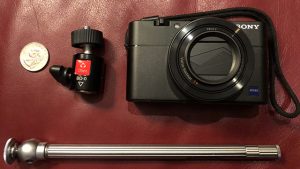
While high end camera phones are coming into their own for taking images at night, I focus on point and shoot sized cameras that can fit in a pocket. With 1″ sensors and the ability to take long manual exposures, you can take night sky images worth publishing.
My current kit is based on an update to the original camera that I’ve had good experience taking nightscape images in the past. The Sony RX100 V has full manual controls and a 1″ sensor with a crop factor of 2.7. This is one of the very smallest cameras with full manual controls.
The Sony RX100 V has features that makes it even better for astrophotography than the original RX100 including: BSI sensor for better low light capability, a full electronic shutter for vibration free bursts, screen that swivels to face the front, time lapse support, and tethered wireless live view remote control software for a smart phone or tablet.
There are three configurations of different weights and capabilities that I use for camera lens based astrophotography:

– Hand held: The lightest kit is to use the camera hand held or resting on a sandbag for long exposures. Weight is less than 9 oz including unfilled sandbag and easily fits in a roomy pocket.
– Mini tripod: A mini-tripod and ball head gives more control and convenience adding 6 to 8 oz. Both can easily fit in a jacket pocket at a total weight of only 1 lb.
– Star tracking drive: A driven mount allows longer exposures and can add panning to time lapse video. I use the very compact Vixen Polarie star tracker which weighs about 2 lbs. with a ball head. This extra weight requires a tripod with a larger stance. I use a ZOMEI Z699C Carbon Fiber Portable Tripod with Ball Head which weighs 2.5 lbs. With the camera the total weight is about 6 lbs. and easily fits in a day pack with room left for dinner and a coat. At this point a larger mirrorless camera and lenses (e.g. Sony a6000 series) will give improved image quality with about 2 lbs. additional weight for a total of about 8 lbs.
For me, a coat pocket kit with mini-tripod is the sweet spot for a small camera. My coat pocket sized kit includes a mini tripod Most mini tripods are designed for views near the horizon and have balance or clearance problems when aimed at the zenith. My solution combines the very light and rigid Minox Pocket Tripod with an Oben BD-0 Mini Ball Head. The combination ensures that the camera will be balanced on the small tripod no matter where I point it in the sky (see Image 1 and Image 2).
Images 3 and 4 were taken with the original RX-100 hand held with whatever support was handy. Image 3 is a sunset conjunction of Jupiter, Venus, and Mercury exposed f/4.9 at ISO 125 for 1.3 sec zoomed to 37.1 mm. Image 4 offers Venus and the Moon with earthshine at the Austin City Limits Music Festival, exposed f/3.5 at ISO 800 for 1/13 sec zoomed to 20.6 mm without tripod. Image 5 was taken using the RX100 on a fixed tripod and features Canis Major and Orion at sunset exposed f/1.8 at ISO 400 for 30 sec zoomed to 10.4 mm.
Image 6 was shot with the newer RX100 V on a tripod. This tiny camera doesn’t have the reach of a super zoom. Other than the Moon, for astrophotography, reach requires a tracking mount. With the extra size and weight, I’m inclined towards an interchangeable lens camera with a larger sensor. Image 6 is a processed stack of 18 images of the waxing gibbous Moon.
Images 7, 8 and 9 were shot with the RX100 V on a tripod and Vixen Polarie. Image 7 offers the Milky Way above the light dome from Burnet, Texas at the Canyon of the Eagles with an RX100 exposed for 15 seconds at ISO 3200 f1.8 at 10.4mm. Image 8 shows the constellation Orion with for 1 hour of total exposure. This shot was taken from inside Austin’s light dome using an ICE LiPo filter to remove light pollution. Image 9 offers a time-lapse stack of a lunar eclipse was captured with the help of the time-lapse app on the Sony RX100 V.
Whatever setup you choose, an ultra-light astrophotography kit is ready to go, anytime, anywhere. And its fun to push the boundaries of imaging the night skies with gear pulled out of your pocket!
###
 Rob Pettengill, Ph.D. received his first telescope when he was eight and he has been a lover of the night sky ever since. Developing his own astrophotography images was a relaxing way to learn skills he needed for his professional research. He implemented signal processing algorithms as custom integrated circuits for medical applications and digital speech at Stanford and Texas Instruments and later built computer aided design and knowledge management systems for MCC and Schlumberger. He now applies what he’s learned in computation, electronics, and imaging as an astrophotographer. He also enjoys urban sidewalk astronomy and traveling with his wife for dark sky adventures.
Rob Pettengill, Ph.D. received his first telescope when he was eight and he has been a lover of the night sky ever since. Developing his own astrophotography images was a relaxing way to learn skills he needed for his professional research. He implemented signal processing algorithms as custom integrated circuits for medical applications and digital speech at Stanford and Texas Instruments and later built computer aided design and knowledge management systems for MCC and Schlumberger. He now applies what he’s learned in computation, electronics, and imaging as an astrophotographer. He also enjoys urban sidewalk astronomy and traveling with his wife for dark sky adventures.
Images 3 – 9
